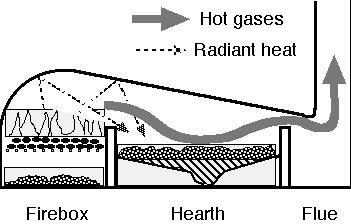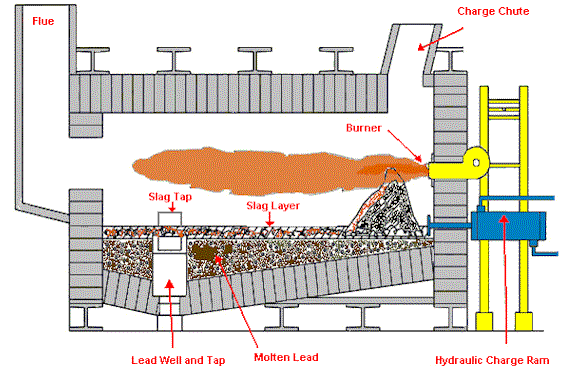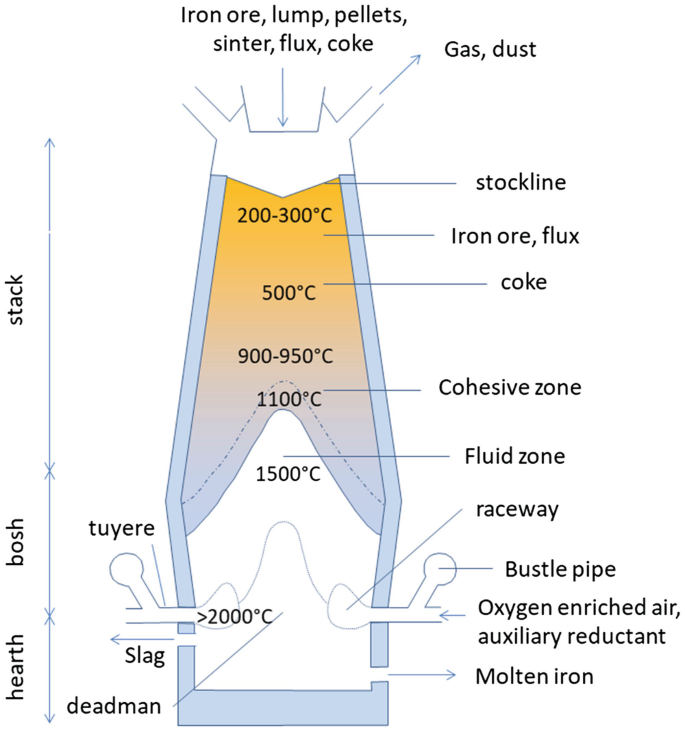The Reverberatory Furnace is an instrument used in metallurgy for the isolation of metal by smelting the ore. The ore which contains the metal is melted by the generation of hot gases at the roof of the furnace. The metal does not come in contact with the fuel which is being used to heat it. It is also called an open-hearth furnace.

Due to primordial design of reverberatory furnace and a very limited temperature range for heating, it is generally used to smelt non-ferrous and softer metals than Iron (Aluminium, Tin, Copper, etc). Reverberatory furnaces have also been used for the smelting of Nickel and other environmentally toxic metals such as Lead.
The term ‘reverberatory’ is used in the sense of reflecting/rebounding. Most metallurgical furnaces rely on conduction (heat transfer from one solid to another) to smelt the ore. Contrary to this, the reverberatory furnace uses convection and radiation for ore smelting, i.e, heat transfer to the ore occurs through the surrounding air, resulting in high amounts of fuel consumption for smelting.
Index
History
The earliest description of a reverberatory furnace was given in a publication by John Rovenson in 1613. One of the earliest diagrams of a working coal reverberatory furnace was given in 1738 by the German metallurgist Schliiter.
The first reverberatory furnaces were used to melt bronze for bell castings in the medieval period. They were initially used to smelt metals in the late 17th century. During this period, the smelting of Iron, Copper and Lead in the reverberatory furnaces was attempted at many places by different individuals.
Sir Clement Klerk and his son Talbot built such reverberatory furnaces in Avon Gorge in Bristol in 1678. Such furnaces had an advantage over primitive methods with mineral coal being used as the fuel, not charcoal or white coal (chopped up dried wood). The furnace was used to melt pig Iron for foundry process in the 1690s.
Reverberatory Furnace Construction
The basic construction of this furnace has remained same, but a number of innovations have been made to improve their production capacity. The simplest construction of such a furnace consists of a steel casing lined by alumina refractory brick or castables with non-wetting qualities, with a lifting door (vertical) at one end and a flue at the other.
Conventional burners (oil/gas) are generally placed on the other end to the door (or on either side of the furnace). A pouring spout is placed opposite to the burner, along with an exhaust gas duct.

The roof of these furnaces is also made from the same refractory bricks, helping in the generation of higher temperatures and hence speeding up the refining process.
Reverberatory Furnace Working
The hearth containes the ore mixture. Heat is transferred over the hearth, which reverberates back. Further heat transfer occurs via the refractory bricks of the walls and roof the furnace. Additional heating cans also be supplied from the burner to the ore.
The roof of the furnace is slightly arched, slanted towards te direction of the flue bridges for further deflection of the reverberatory flame. The ore mixture is continuously heated until it melts.
The impure metal is collected in the thick hearth, which is made dense and impervious such that the contents cannot penetrate it. The walls are made with a material resistant to any chemical attack by the slag.
The ore is charged via the openings in the roof and the generated slag rises to the top and is let to overflow. The ore concentrate is then tapped at regular intervals and then sent to a converter for further processing.
Advantages and Disadvantages of Using Reverberatory Furnace
Now that we have looked at the construction and working of reverberatory furnace. Let’s look at the advantages and disadvantages of using this furnace.
Advantages
- High volume processing rate.
- Low maintenance and operating costs.
Disadvantages
- Large floor space requirements.
- Very high rate of metal oxidation.
- Poor efficiency.
Reverberatory Furnace Applications
- Smelting /refining of metals such as Nickel, Copper, Tin, etc.
- In steel making (open-hearth process; now very obsolete).
FAQs
It is a metallurgical furnace used for extraction of metals like Tin, Copper, Aluminium, etc and the production of specific cements and concretes. The furnace is primarily used for the smelting and refining these materials.
The process of smelting (metallurgical process used to produce metal from the ore, using heat and a chemical reducing agents (charcoal, coke, coal) for decomposing the ore, removing other materials as gases or slag and only leaving the metal behind) takes place in this furnace.
The major difference between a reverberatory furnace and blast furnace is that the fuel does not come in contact with the ore in a reverberatory furnace, but the fuel is generally mixed with the ore in a blast furnace (no separation between fuel and material).
A blast of hot air (sometimes Oxygen enriched) is used in the combustion process (along with fuel) in a blast furnace, which is not done in a reverberatory furnace. Fig. Blast Furnace Diagram (Source)
Fig. Blast Furnace Diagram (Source)
